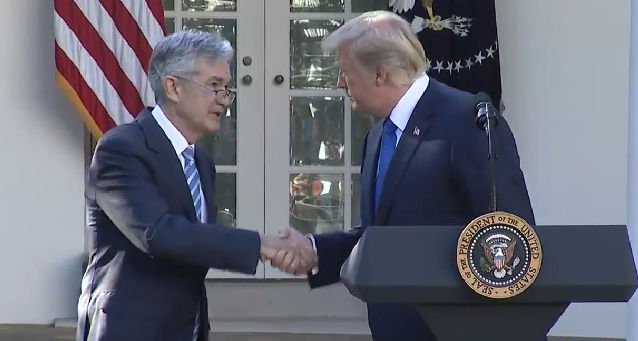Powell não vê melhora no panorama econômico e pavimenta corte de juro

O presidente do Federal Reserve Jerome Powell destacou nesta quarta-feira (10) que o panorama econômico não demonstrou melhora nas últimas semanas, sinalizando que poderá ocorrer afrouxamento monetário na próxima reunião do FOMC (Federal Open Market Committee).
“Aparentemente incertezas diante das tensões comerciais e preocupações sobre a força da economia global continuam a pesar sobre o horizonte da economia norte-americana”, avalia o presidente do Fed.
Embora tenha afirmado que as “pressões inflacionárias mantiveram-se caladas”, a expectativa de que haja arrefecimento na variação positiva no nível geral de preços, indicando enfraquecimento da economia, corroboram para maior expectativa de corte no juro básico a frente.
Confira íntegra do discurso de Powell:
Chairwoman Waters, Ranking Member McHenry, and other members of the Committee, I am pleased to present the Federal Reserve’s semiannual Monetary Policy Report to Congress.
Let me start by saying that my colleagues and I strongly support the goals of maximum employment and price stability that Congress has set for monetary policy. We are committed to providing clear explanations about our policies and activities. Congress has given us an important degree of independence so that we can effectively pursue our statutory goals based on objective analysis and data. We appreciate that our independence brings with it an obligation for transparency so that you and the public can hold us accountable.
Today I will review the current economic situation and outlook before turning to monetary policy. I will also provide an update of our ongoing public review of our framework for setting monetary policy.
Current Economic Situation and Outlook
The economy performed reasonably well over the first half of 2019, and the current expansion is now in its 11th year. However, inflation has been running below the Federal Open Market Committee’s (FOMC) symmetric 2 percent objective, and crosscurrents, such as trade tensions and concerns about global growth, have been weighing on economic activity and the outlook.
The labor market remains healthy. Job gains averaged 172,000 per month from January through June. This number is lower than the average of 223,000 a month last year but above the pace needed to provide jobs for new workers entering the labor force. Consequently, the unemployment rate moved down from 3.9 percent in December to 3.7 percent in June, close to its lowest level in 50 years. Job openings remain plentiful, and employers are increasingly willing to hire workers with fewer skills and train them. As a result, the benefits of a strong job market have been more widely shared in recent years. Indeed, wage gains have been greater for lower-skilled workers. That said, individuals in some demographic groups and in certain parts of the country continue to face challenges. For example, unemployment rates for African Americans and Hispanics remain well above the rates for whites and Asians. Likewise, the share of the population with a job is higher in urban areas than in rural communities, and this gap widened over the past decade. A box in the July Monetary Policy Report provides a comparison of employment and wage gains over the current expansion for individuals with different levels of education.
Gross domestic product increased at an annual rate of 3.1 percent in the first quarter of 2019, similar to last year’s pace. This strong reading was driven largely by net exports and inventories—components that are not generally reliable indicators of ongoing momentum. The more reliable drivers of growth in the economy are consumer spending and business investment. While growth in consumer spending was weak in the first quarter, incoming data show that it has bounced back and is now running at a solid pace. However, growth in business investment seems to have slowed notably, and overall growth in the second quarter appears to have moderated. The slowdown in business fixed investment may reflect concerns about trade tensions and slower growth in the global economy. In addition, housing investment and manufacturing output declined in the first quarter and appear to have decreased again in the second quarter.
After running close to our 2 percent objective over much of last year, overall consumer price inflation, measured by the 12-month change in the price index for personal consumption expenditures (PCE), declined earlier this year and stood at 1.5 percent in May. The 12-month change in core PCE inflation, which excludes food and energy prices and tends to be a better indicator of future inflation, has also come down this year and was 1.6 percent in May.
Our baseline outlook is for economic growth to remain solid, labor markets to stay strong, and inflation to move back up over time to the Committee’s 2 percent objective. However, uncertainties about the outlook have increased in recent months. In particular, economic momentum appears to have slowed in some major foreign economies, and that weakness could affect the U.S. economy. Moreover, a number of government policy issues have yet to be resolved, including trade developments, the federal debt ceiling, and Brexit. And there is a risk that weak inflation will be even more persistent than we currently anticipate. We are carefully monitoring these developments, and we will continue to assess their implications for the U.S economic outlook and inflation.
The nation also continues to confront important longer-run challenges. Labor force participation by those in their prime working years is now lower in the United States than in most other nations with comparable economies. As I mentioned, there are troubling labor market disparities across demographic groups and different parts of the country. The relative stagnation of middle and lower incomes and low levels of upward mobility for lower-income families are also ongoing concerns. In addition, finding ways to boost productivity growth, which leads to rising wages and living standards over the longer term, should remain a high national priority. And I remain concerned about the longer-term effects of high and rising federal debt, which can restrain private investment and, in turn, reduce productivity and overall economic growth. The longer-run vitality of the U.S. economy would benefit from efforts to address these issues.
Monetary Policy
Against this backdrop, the FOMC maintained the target range for the federal funds rate at 2‑1/4 to 2-1/2 percent in the first half of this year. At our January, March, and May meetings, we stated that we would be patient as we determined what future adjustments to the federal funds rate might be appropriate to support our goals of maximum employment and price stability.
At the time of our May meeting, we were mindful of the ongoing crosscurrents from global growth and trade, but there was tentative evidence that these crosscurrents were moderating. The latest data from China and Europe were encouraging, and there were reports of progress in trade negotiations with China. Our continued patient stance seemed appropriate, and the Committee saw no strong case for adjusting our policy rate.
Since our May meeting, however, these crosscurrents have reemerged, creating greater uncertainty. Apparent progress on trade turned to greater uncertainty, and our contacts in business and agriculture report heightened concerns over trade developments. Growth indicators from around the world have disappointed on net, raising concerns that weakness in the global economy will continue to affect the U.S. economy. These concerns may have contributed to the drop in business confidence in some recent surveys and may have started to show through to incoming data.
In our June meeting statement, we indicated that, in light of increased uncertainties about the economic outlook and muted inflation pressures, we would closely monitor the implications of incoming information for the economic outlook and would act as appropriate to sustain the expansion. Many FOMC participants saw that the case for a somewhat more accommodative monetary policy had strengthened. Since then, based on incoming data and other developments, it appears that uncertainties around trade tensions and concerns about the strength of the global economy continue to weigh on the U.S. economic outlook. Inflation pressures remain muted.
The FOMC has made a number of important decisions this year about our framework for implementing monetary policy and our plans for completing the reduction of the Fed’s securities holdings. At our January meeting, we decided to continue to implement monetary policy using our current policy regime with ample reserves, and emphasized that we are prepared to adjust any of the details for completing balance sheet normalization in light of economic and financial developments. At our March meeting, we communicated our intention to slow, starting in May, the decline in the Fed’s aggregate securities holdings and to end the reduction in these holdings in September. The July Monetary Policy Report provides details on these decisions.
The July Monetary Policy Report also includes an update on monetary policy rules. The FOMC routinely looks at monetary policy rules that recommend a level for the federal funds rate based on inflation and unemployment rates. I continue to find these rules helpful, although using these rules requires careful judgment.
We are conducting a public review of our monetary policy strategy, tools, and communications—the first review of its kind for the FOMC. Our motivation is to consider ways to improve the Committee’s current policy framework and to best position the Fed to achieve maximum employment and price stability. The review has started with outreach to and consultation with a broad range of people and groups through a series of Fed Listens events. The FOMC will consider questions related to the review at upcoming meetings. We will publicly report the outcome of our discussions.
Thank you. I am happy to respond to your questions.




![[Conteúdos gratuitos] Assista ao Giro do Mercado e outros programas exclusivos em nosso Youtube](https://www.moneytimes.com.br/uploads/2024/01/banner-html-28.png)








